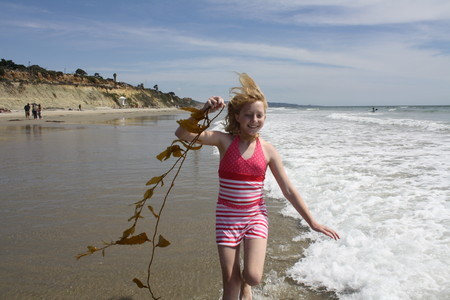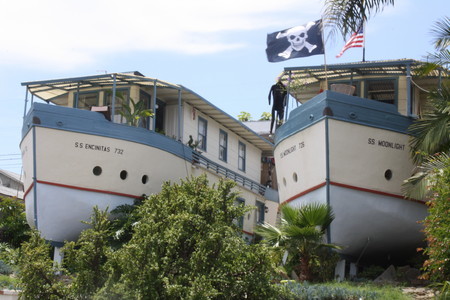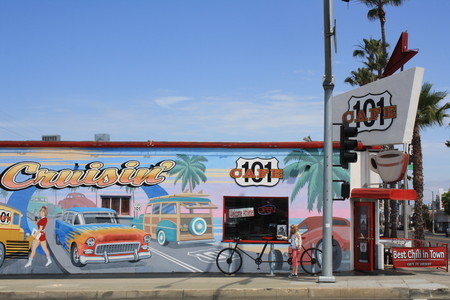Pure California
Cruising California's Historic Route 101, in San Diego North, might not be the fastest way down the Southern California coast, but investing a little extra time will reward you many times over in beauty and unusual experiences. Like Route 66, this is an iconic American road full of culture, unique architecture and lifestyles, yet this drive has an added bonus -- the Pacific Ocean.
My 12-year-old daughter and I spent a full day exploring this 32-mile drive from Oceanside to La Jolla, stopping at places that suited our fancy, some old and some new, yet all of them quintessential to Southern California. By the end of our jam-packed day, we had confirmed the old axiom that more often than not, it's the journey that's important, not the destination.
Regionally known as the Coast Highway, or Highway 101, this route is all about slowing down and perhaps getting a little wistful for days gone by.
We started our tour in Oceanside, stopping in at the town's oldest restaurant, Café 101, opened in 1928. Here, we met up with John Daly, the diner's affable co-owner. We have broken bread with Daly before, and it was good to see he was his old jovial self. We sat down with him for awhile, had some breakfast and learned about Highway 101.
"It's Route 66 with a view," Daly explained. Just as Route 66 became "The Mother Road," symbol of the westering experience for dust bowl refugees in the 1930s, tourists in mid-century, and an unprecedented westward migration over several decades, so Highway 101 came to symbolize the West Coast experience. It was the route one followed to see surfers, feel the sand between the toes or to find the perfect California experience.
Of course, the ocean is what drew people here in the first place. "All early development happened along the coast," Daly said, adding, "Even today, about 75 percent of California's people live within 20 miles of the coast."
This coastal stretch alone, he added, accesses "six very eclectic communities that all have a different allure."
Since we had visited Oceanside just last year and wanted to get our road trip started, we bypassed some of the highlights we enjoyed there last time. But I remember them well enough to recommend Oceanside's excellent beaches; its harbor area with quaint shops, boat rentals and boat tours; and walking the 1,942-foot wooden pier, the longest on the West Coast.
We did, however, take time to revisit one of the town's many museums. Lying along Highway 101 are some of the world's best beaches for surfing, and the California Surf Museum salutes them all. Since our last visit, the museum has moved into new and more extensive quarters only about a block from the ocean. Even if you aren't a surfer, this is an enjoyable place to visit. Surfing culture seems forever youthful and therefore unchanging, but rotating exhibits of old photos and historic surfboards make it clear that the equipment has changed plenty. We saw a Waikiki-style board, made in about 1922 from varnished redwood, that is nine feet, eight inches long.
Highway 101 is also about roadside culture.
"One thing just about all Americans share is the experience of growing up with the automobile," Daly said.
He noted that the old service stations and auto courts are still recognizable, even though nearly all of them are used now for some other kind of business. Daly said even young people stop in at his art-deco-styled building just because of the way it looks. During America's drive-in craze, former owners built an overhang on the north side of the building to shelter outdoor customers and carhops -- the waitresses and waiters who toted chow to those who preferred "to dine in the comfort of their own cars," as the drive-in-advertising mantra said. "Curb service" is no longer available here, but the cozy inside booths, counter-stool service, old photographs and diner-style food will bring back memories.
Heading south, we stopped in Carlsbad. The town is very well known to American children because it is where Legoland is located.
It is also home to the Army and Navy Academy, a college preparatory, residential and day school, and to a multitude of first-rate shops, restaurants and places to stay.
The Museum of Making Music celebrates 100 years of America's rhythms. Besides displaying more than 450 vintage instruments and artifacts, there are interactive areas where you can try playing more than a dozen instruments, such as electric guitars, violins, drums and keyboards.
Even those with no musical ability will enjoy experimenting with the McNally Strumstick, a stringed instrument that uses a diatonic fretting system, making everything you play sound on key.
Carlsbad's Village Street Faire takes place twice a year, in May and November, and is the largest of its sort in the United States, boasting more than 900 vendors and crowds around the 100,000 mark. This fall's fair takes place on Nov. 1, and it is a good place to get a jump on your holiday shopping, as the fair features every type of booth imaginable from clothing to crafts, fine art and antiques.
While there is no shortage of boats in Southern California, we stopped in a suburban Encinitas neighborhood to see two that have never left dry land. The S.S. Moonlight and the S.S. Encinitas sit side-by-side where they were built in the late 1920s and have been assigned street addresses. An enterprising local man, ahead of his time as far as recycling is concerned, used lumber from the once popular Moonlight dance house, which went under during the Prohibition years.
These vessels never were intended to be launched. Last year, the Encinitas Preservation Association purchased the boat houses. Until the group pays off a hefty mortgage, the houses will still be rented out, but the plan is to turn them into a museum eventually.
Our next stop was Del Mar, where we were staying at one of the town's premiere hotels, L'Auberge Del Mar Resort and Spa. Our second-floor room had a patio, overlooking the pool with views down to the ocean. Del Mar has the feel of a small village, although it has 60 shops and more than 25 restaurants.
At the hotel's Kitchen 1540, we ate outdoors in our own private cabana. Although they offered such entrees as bison tartar and Hiramasa crudo, we stuck to the familiar, choosing salmon and roasted spring chicken that we supplemented with an artichoke dish, Day Boat scallops and sautéed wax beans.
Torrey Pines State Natural Reserve was named for America's rarest pine tree. Torrey pines grow naturally here at the park and in a small grove on Santa Rosa Island off the coast of Santa Barbara; the latter are a subspecies, not exactly the same as the ones on the mainland.
The 2,000-acre reserve is a great experience for birders, wildlife lovers and hikers, as there are eight miles of trails.
The trails are perhaps the park's best feature. Some bring you to a bluff that rises 300 feet above the water.
The 0.7-mile Guy Fleming Loop Trail is a good choice for first timers and provides sweeping ocean views. It's good to bring your binoculars on this trail to catch a glimpse of the gray whales making their seasonal migration. In October, these whales begin their migration from the Bering and Chukchi Seas (between Alaska and Siberia) on down to Baja California, for mating and calving. This is a 10,000-mile round-trip that takes a whale two to three months each way. This bluff is one of the best places from which to scan the water for a sight of the travelers, and the calm seas of December through March offer the best time to watch.
We finished up driving into La Jolla, where we would spend a couple of more days enjoying that town's virtues. But the first priority, after a day so tantalizingly close to so many fine California beaches, was a swim in the ocean that made so many people fall in love with the coast of California. And as I plunged into the refreshingly cold surf of the timeless Pacific, I thought to myself, "It still does that!"
GETTING THERE
Location: Adventure begins in Oceanside, Calif., in northern San Diego County, about 308 miles southwest of Las Vegas, and continues 32 miles south to La Jolla.
Directions: From Las Vegas, take Interstate 15 south for about 241 miles, merge onto California Route 91 south and drive 9.7 miles, merge onto California Route 241 south and drive 12.2 miles, merge onto California Route 133 south. Drive 3.8 miles and merge onto Interstate 5 south and drive 41 miles to exit 54B, the Coast Highway (Highway 101) and Oceanside. Continue south 32 miles on Route 101, stopping frequently for fun.
Lodging: L'Auberge, Del Mar Spa and Resort, 1540 Camino Del Mar, Del Mar. (800) 553-1336, www.laubergedelmar.com. Wyndham Oceanside Pier Resort, 333 N. Meyers, Oceanside, (760) 901-1205, www.wyndhamworldwide.com. Oceanside Marina Suites, 2008 Harbor Drive North, Oceanside, (760) 722-1561, www.omihotel.com. La Valencia Hotel, 1132 Prospect St., La Jolla, (800) 451-0772, www.lavalencia.com.
Café 101: Breakfast (served all day), lunch and dinner. Open daily, except Christmas, 7 a.m.-midnight, 631 South Coast Highway, Oceanside, (760) 722-5220, www.cafe101.net.
California Surf Museum: Open daily 10 a.m.-4 p.m., Thursdays until 8 p.m., closed major holidays. 312 Pier View Way, Oceanside, (760) 721-6876, www.surfmuseum.org.
Museum of Making Music: Open 10 a.m.-5 p.m. Tuesdays through Sundays, closed major holidays. 5790 Armada Drive, Carlsbad, (760) 438-5996, www.museumofmakingmusic.org.
Encinitas Boat Houses: These can only be viewed from the street, and there are no tours. From Route 101 go west onto West D Street then left on Third Street. Follow to boat houses on your right, at 726 and 732 Third Street..
Legoland California: One Legoland Drive, Carlsbad, (760) 918-5346, www.legoland.com.
Torrey Pines State Reserve: Open daily 8 a.m. to sunset. 12600 North Torrey Pines Road. (858) 755-2063. www.torreypine.org.
San Diego North Convention and Visitor's Bureau: Information on area attractions, lodging and restaurants. (800) 848-3336, www.sandiegonorth.com/




















